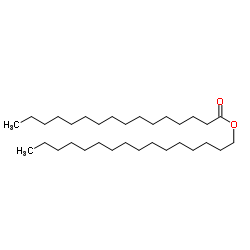CETYL PALMITATE

CETYL PALMITATE structure
|
Common Name | CETYL PALMITATE | ||
|---|---|---|---|---|
| CAS Number | 540-10-3 | Molecular Weight | 480.849 | |
| Density | 0.9±0.1 g/cm3 | Boiling Point | 507.0±18.0 °C at 760 mmHg | |
| Molecular Formula | C32H64O2 | Melting Point | 55-56 °C(lit.) | |
| MSDS | Chinese USA | Flash Point | 269.8±11.1 °C | |
|
Solid Lipid Nanoparticles: A Potential Multifunctional Approach towards Rheumatoid Arthritis Theranostics.
Molecules 20 , 11103-18, (2015) Rheumatoid arthritis (RA) is the most common joint-related autoimmune disease and one of the most severe. Despite intensive investigation, the RA inflammatory process remains largely unknown and finding effective and long lasting therapies that specifically t... |
|
|
Evaluation of Photoprotective Potential and Percutaneous Penetration by Photoacoustic Spectroscopy of the Schinus terebinthifolius Raddi Extract.
Photochem. Photobiol. 91 , 558-66, (2015) Schinus terebinthifolius is a plant rich in phenolic compounds, which have antioxidant properties and can provide new opportunities for treatment and prevention of diseases mediated by ultraviolet radiation like photoaging and skin cancer. The aim of this stu... |
|
|
Defensive Armor of Potato Tubers: Nonpolar Metabolite Profiling, Antioxidant Assessment, and Solid-State NMR Compositional Analysis of Suberin-Enriched Wound-Healing Tissues.
J. Agric. Food Chem. 63 , 6810-22, (2015) The cultivation, storage, and distribution of potato tubers are compromised by mechanical damage and suboptimal healing. To investigate wound-healing progress in cultivars with contrasting russeting patterns, metabolite profiles reported previously for polar ... |
|
|
Lipid-based capsaicin-loaded nano-colloidal biocompatible topical carriers with enhanced analgesic potential and decreased dermal irritation.
J. Liposome Res. 24(4) , 290-6, (2014) Capsaicin (CP), a recent FDA-approved drug for the topical treatment of neuropathic pain, is associated with several side effects like irritation, burning sensation, and erythema, resulting in poor patient compliance. The present study is an attempt to study ... |
|
|
Idebenone loaded solid lipid nanoparticles: calorimetric studies on surfactant and drug loading effects.
Int. J. Pharm. 471(1-2) , 69-74, (2014) In this study we prepared solid lipid nanoparticles (SLN), by the phase inversion temperature (PIT) method, using cetyl palmitate as solid lipid and three different non-ionic emulsifiers of the polyoxyethylene ethers family (ceteth-20, isoceteth-20, oleth-20)... |
|
|
The critical role of didodecyldimethylammonium bromide on physico-chemical, technological and biological properties of NLC.
Colloids Surf. B Biointerfaces 121 , 1-10, (2014) Exploiting the experimental factorial design and the potentiality of Turbiscan AG Station, we developed and characterized unmodified and DDAB-coated NLC prepared by a low energy organic solvent free phase inversion temperature technique. A 22 full factorial e... |
|
|
Lipid nanocarriers based on natural oils with high activity against oxygen free radicals and tumor cell proliferation.
Mater. Sci. Eng. C. Mater. Biol. Appl. 56 , 88-94, (2015) The development of nano-dosage forms of phytochemicals represents a significant progress of the scientific approach in the biomedical research. The aim of this study was to assess the effectiveness of lipid nanocarriers based on natural oils (grape seed oil, ... |
|
|
Loading hydrophilic drug in solid lipid media as nanoparticles: statistical modeling of entrapment efficiency and particle size.
Int. J. Pharm. 424(1-2) , 128-37, (2012) Solid lipid nanoparticle (SLN) is a very well tolerated carrier systems for dermal application due to the employment physiological and/or biodegradable lipids. The effects of five factors, two categorical and three quantitative factors, were studied on the me... |
|
|
In vitro evaluation of idebenone-loaded solid lipid nanoparticles for drug delivery to the brain.
Drug Dev. Ind. Pharm. 37(6) , 737-46, (2011) Solid lipid nanoparticles (SLN) are regarded as interesting drug delivery systems and their preparation techniques have gained a great deal of attention.To evaluate the feasibility of preparing idebenone (IDE) loaded SLN from O/W microemulsions by the phase-i... |
|
|
Ultra-small lipid nanoparticles promote the penetration of coenzyme Q10 in skin cells and counteract oxidative stress.
Eur. J. Pharm. Biopharm. 89 , 201-7, (2015) UV irradiation leads to the formation of reactive oxygen species (ROS). An imbalance between the antioxidant system and ROS can lead to cell damage, premature skin aging or skin cancer. To counteract these processes, antioxidants such as coenzyme Q10 (CoQ10) ... |